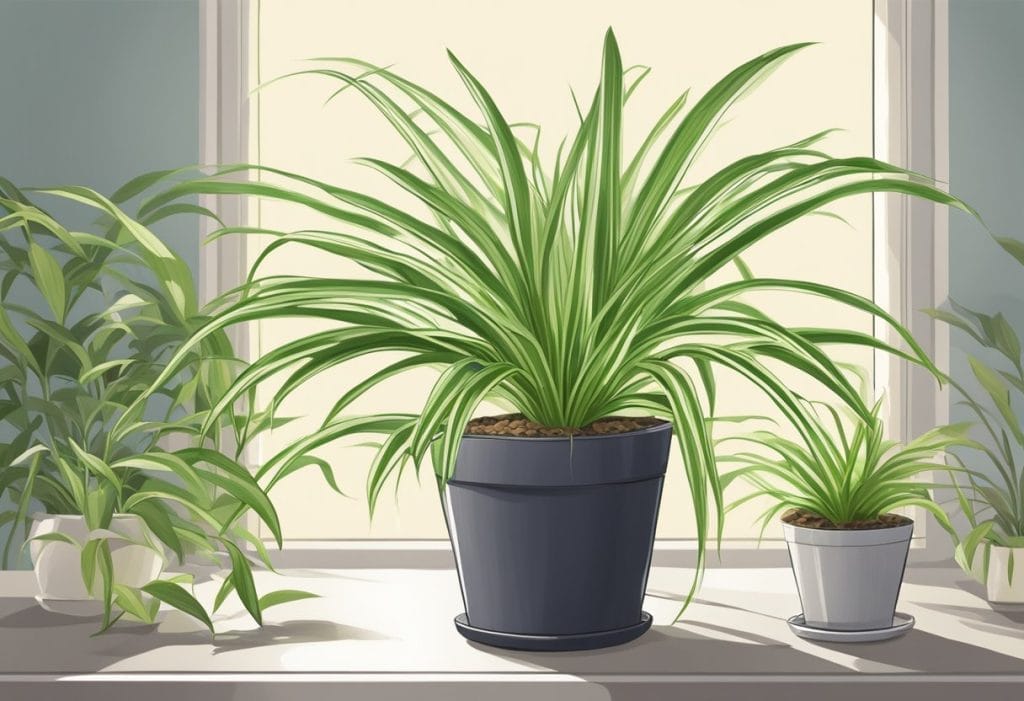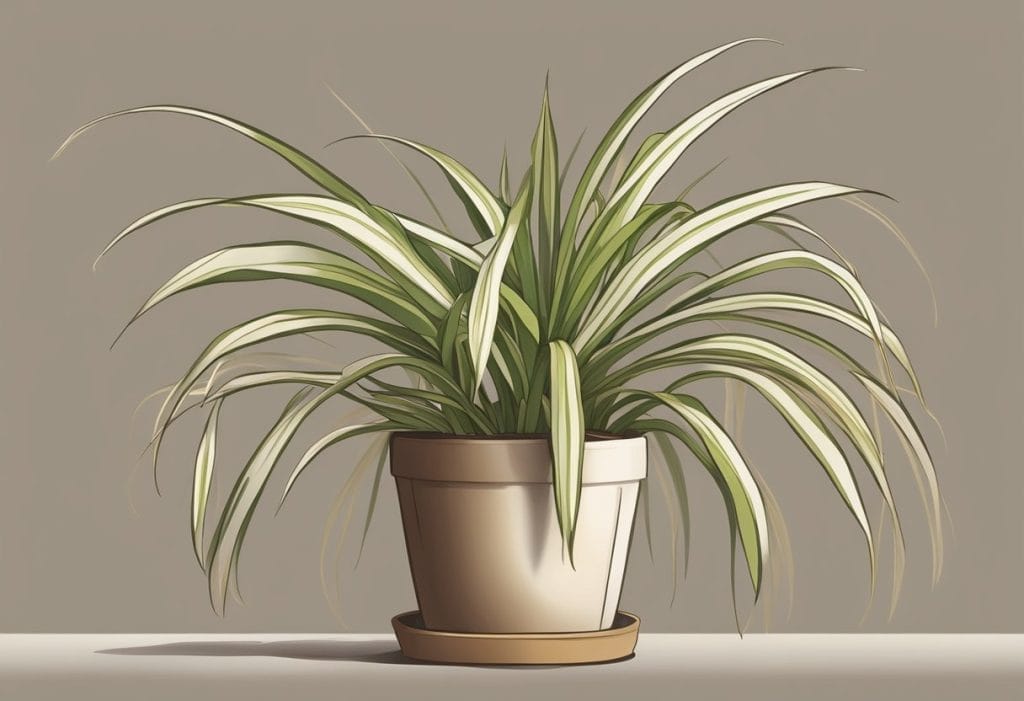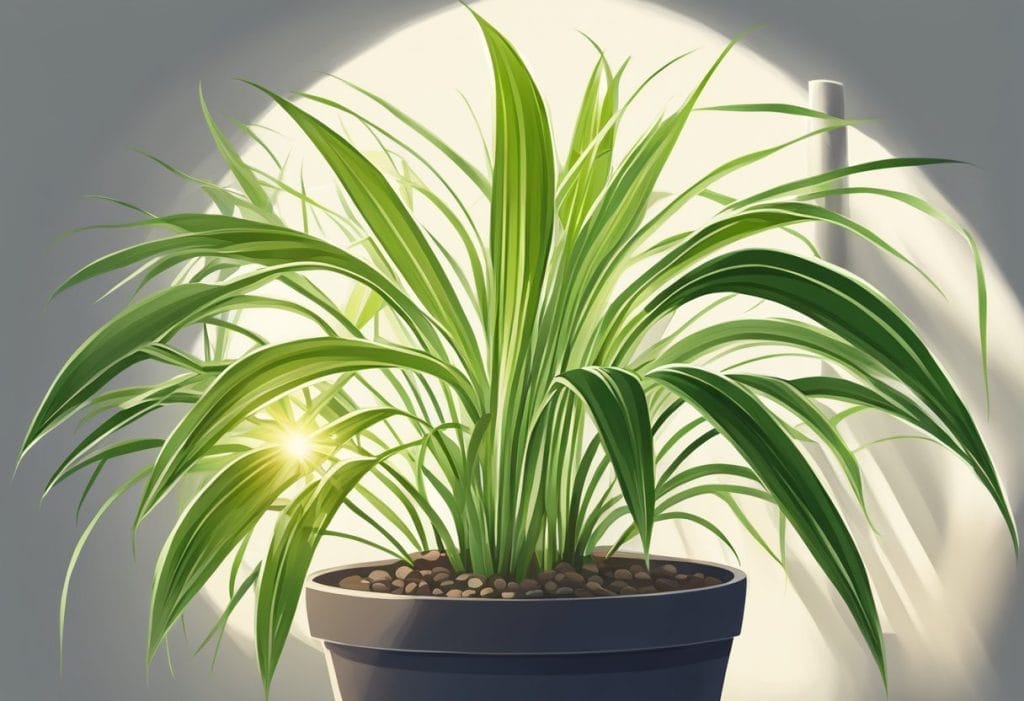10 Reasons Why Your Spider Plant Isn’t Producing Babies [Causes + Solutions]
Spider plants (Chlorophytum comosum) are popular houseplants known for their low-maintenance needs and distinctive appearance, featuring arching leaves and unique cascading “babies” or plantlets. However, sometimes you might find that your spider plant isn’t producing these much-desired babies, causing you concern and leading you to question whether the plant is thriving.

In this article, we will discuss nine possible reasons for your spider plant’s lack of offspring, ensuring you have the knowledge required to create the ideal environment for these attractive indoor plants. By addressing common issues such as watering, temperature, and pest control, you will be better equipped to foster conditions that encourage the growth of new plantlets and keep your spider plant healthy and productive.
Optimizing Growing Conditions

To ensure that your spider plant produces babies, optimizing its growing conditions is essential. Here are some factors to consider:
Proper Lighting
Spider plants thrive in indirect sunlight. Placing your plant near a bright window where it receives filtered light is ideal. Direct sunlight may cause leaf scorching, while insufficient light can hinder growth and the production of babies. Aim for at least 6-8 hours of indirect sunlight daily to encourage your spider plant’s healthy growth.
Ideal Temperature
These plants prefer a temperature range of 65-75°F (18-24°C) during the day and slightly cooler temperatures at night. Keep your plant away from heating and cooling vents, as drastic temperature fluctuations can cause stress and impede its ability to produce babies. Ensure a consistent temperature to maintain a healthy environment for your plant.
Balanced Watering
Spider plants require a consistent watering schedule. They should not be allowed to dry out completely between waterings. Instead, water your plant when the soil is 50-75% dry. Overwatering can lead to root rot, while underwatering can prevent the production of babies. Here’s an easy way to assess the soil moisture:
- 1-2 inches dry: Time to water
- Moist: Wait a day or two before checking again
- Soggy: Hold off on watering and improve drainage
Suitable Soil and Container
A well-draining potting soil is essential for the health of your spider plant. Choose a soil mix that contains a combination of peat, vermiculite, and perlite. This will help retain moisture, while also allowing excess water to drain.
Ensure your container has drainage holes to prevent water from pooling and causing root rot. A pot that is too large may overaccumulate water and impede your plant’s production of babies. Select a pot that is slightly smaller than the width of the plant’s foliage, as spider plants tend to produce babies when they are slightly root-bound.
By addressing these key factors in your spider plant’s growth, you’ll create an environment that encourages the production of healthy, happy baby plants.
Understanding Plant Health

Detecting and Preventing Root Rot
Root rot is a common issue that can hinder the growth of your spider plant and prevent it from producing babies. To detect root rot, keep an eye out for yellowing leaves or wilting stems. If you notice any of these signs, gently remove the plant from the pot to inspect its roots. Healthy roots should be firm and white, while rotten roots will be soft and brown.
To prevent root rot, be mindful of your watering habits. Overwatering can lead to insufficient oxygen in the soil, which encourages the growth of harmful fungi and bacteria. Water your spider plant when the soil is 50-75% dry and make sure that your pot has proper drainage to avoid waterlogged soil.
Avoiding Pests and Diseases
Pests can significantly damage your spider plant, causing it to wilt and cease producing babies. Some of the most common pests affecting spider plants are aphids, spider mites, and whiteflies. To avoid pest infestations, keep your plants clean and dust-free. Regularly inspect your plant for any signs of pests, and treat them promptly if needed. You can use natural remedies like neem oil or insecticidal soap to control pests.
Maintaining good hygiene and avoiding overwatering will help prevent diseases as well. Spider plants prefer to be well-drained and are sensitive to high concentrations of fluoride in tap water. To mitigate this, try using rain or distilled water to irrigate your plant.
Regulating Humidity Levels
Spider plants thrive in a humid environment, and low humidity levels may discourage its growth and production of babies. You can easily increase humidity around your plant by:
- Placing it on a humidity tray filled with pebbles and water. The water will evaporate and create a micro-humid environment around the plant.
- Grouping your spider plants with other plants, as this creates a natural humid atmosphere.
- Using a humidifier to maintain optimum humidity levels in the room where your plant is located.
Keep in mind that overfertilizing can contribute to plant stress and hinder spider plant babies from forming. Stick to a balanced, slow-release fertilizer and follow the application instructions carefully.
By addressing these key aspects of plant health, you’ll create an ideal environment for your spider plant to thrive and produce babies.
Fostering Reproduction

Promoting Flowering
To help your spider plant produce babies, it’s essential to create a comfortable environment that encourages flowering. Start by ensuring that the plant is in a pot that is just slightly larger than the root ball. Spider plants prefer temperatures between 65°F (18°C) and 75°F (23°C) during the day and around 55°F (12°C) at night. Make sure not to over-fertilize, as too much fertilizer can hinder flower production. Instead, provide the plant with moderate amounts of nutrients by using a balanced fertilizer.
It’s also important to keep in mind the quality of water you’re using for your spider plant. High concentrations of fluoride and other chemicals in tap water may negatively affect the plant. Instead, consider using rain or distilled water to irrigate your plant.
Encouraging Plantlet Formation
Once your spider plant starts flowering, it’s time to encourage plantlet formation. Maintaining an optimal balance of light is crucial; too much light at night can disrupt the plant’s ability to form plantlets. Make sure your plant receives bright, indirect sunlight during the day and is in a darker environment during the night.
Proper watering is another key factor in encouraging plantlet growth. Underwatering can be detrimental to baby spider plants. It’s essential to water your spider plant when the soil becomes 50-75% dry. Remember to use rain or distilled water to avoid chemical buildup.
Techniques for Propagation
When your spider plant starts producing plantlets, you can begin the propagation process, turning the plantlets into new, independent plants. Here are some techniques to help propagate your plant successfully:
- Air Layering: Let the plantlets develop while still attached to the mother plant. Once they have a few roots, you can secure them onto a small pot filled with moist soil, all the while remaining attached to the parent plant. Once the plantlet is well-established, cut the connecting stem.
- Cutting: Remove a healthy plantlet from the mother plant and place it into a container with fresh, moist soil. Keep the soil consistently moist to foster root development.
- Water Propagation: Cut a mature plantlet and place it in a jar of water. Change the water every few days to keep it fresh. Once roots have formed, transfer the plantlet into its own pot with soil.
Follow these techniques, and you’ll have success in propagating your spider plant and fostering reproduction for future generations of plantlets!
Maintaining Plant Nutrition

Using the Right Fertilizer
Choosing the right fertilizer for your spider plant (Chlorophytum) is crucial to ensure it thrives and produces babies. Spider plants are heavy feeders and require a balance of nutrients to encourage healthy growth. The ideal fertilizer for this purpose should contain a balanced mix of nitrogen, phosphorus, and potassium (N-P-K). A quality organic fertilizer or an all-purpose houseplant fertilizer will suffice.
Here’s a recommended fertilization schedule:
- Spring and Summer: Fertilize your spider plant once per month with a water-soluble fertilizer at half strength.
- Fall and Winter: Reduce fertilization to once every two months to avoid overfeeding since the plant’s growth slows down during these seasons.
Remember to follow the specific instructions provided on the fertilizer packaging, as over-fertilizing can actually inhibit the production of babies, or spiderettes.
Preventing Nutrient Deficiency
Nutrient deficiencies can affect the overall health and fertility of your spider plant. To prevent such deficiencies and keep your plant healthy, ensure it receives the appropriate amount of water and nutrients. Spider plants can be sensitive to the chemicals found in tap water, such as fluoride and chlorine, which may cause discolored leaves or prevent baby production.
Consider these measures to help prevent nutrient deficiencies:
- Water source: Use rainwater or distilled water to irrigate your plant, avoiding the potentially harmful chemicals present in tap water.
- Temperature: Maintain ideal daytime temperatures of 65°F to 75°F (18°C – 23°C) and nighttime temperatures of around 55°F (12°C). This temperature range promotes flowering and increases the chance of baby formation.
By taking care of your spider plant’s nutritional needs with the right fertilizer and proper watering, you can help ensure the healthy growth of its foliage and increase its chances of producing spiderettes.
Managing Environmental Stressors
Preventing Physical Damage
Stress can affect your spider plant’s ability to produce babies. One significant stress factor to address is physical damage. To prevent damage, ensure your plant is placed in a safe location away from foot traffic or activities that could accidentally harm it. Additionally, protect your spider plant from strong winds if it is placed outdoors.
Regularly inspect your plant for signs of pest infestation. Pests can cause physical damage, ultimately affecting the growth of babies. If you notice signs of pests, take necessary measures to eliminate them and maintain your plant’s overall health.
Adapting to Seasonal Changes
Your spider plant’s ability to produce babies can also be influenced by seasonal changes, particularly temperature fluctuations. During the summer season, remember to move your spider plant to a shady spot to prevent it from getting exposed to excessive heat. This will help maintain the right balance of temperature needed for healthy growth and baby production.
Here are some key temperature tips to consider for your spider plant:
- Maintain a temperature range of 60-75°F (15-24°C).
- Avoid sudden temperature changes, as this can lead to stress and baby production issues.
- Ensure the plant is not placed near heating or cooling vents.
Lastly, keep in mind that environmental stressors like humidity and sunlight play a crucial role too. Gradually adapt your spider plant to its environment by increasing or decreasing the intensity and duration of light, based on the season and your plant’s specific needs.
By proactively managing environmental stressors and ensuring your spider plant is well cared for, you will create the ideal conditions for it to thrive and produce healthy babies.







